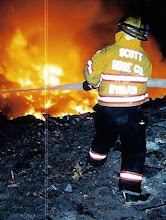Most of the focus on fighting forest fires; the tools,
techniques, and tactics, have long been on the West. The beginnings, though, came from one of our
own; a Pennsylvanian. Gifford Pinchot,
who served two terms as Governor, headed the Forest Service in the early 1900s,
starting under President McKinley, and through the administration of his friend
and supporter, Theodore Roosevelt. In
the early days, Pinchot was a Forester with no forest, as control of the actual
Federal land was in the General Land Office.
Finally, in 1905, Roosevelt was able to out maneuver the land barons’
both in and outside of Congress, and transfer control of the forests to
Pinchot’s agency, the newly named United States Forest Service.
The danger of fire was one of the ways in which Pinchot
convinced a reluctant Congress to fund his corps of green shirted rangers. The danger was not illusory. In 1871, the Pestigo fire in Wisconsin burned
over a million acres and killed 1,182 people.
In Minnesota in 1894, another tragic fire struck which killed 413
people. Pinchot knew that fire was
necessary and in some cases beneficial to forests and understood that nature
could never be completely controlled.
His fire control efforts started a debate which continues to this day as
to where to draw that line.
The rangers on the front lines were highly motivated by
poorly paid; a miserable salary even for the day of $900 per year. Pinchot’s directions to them on fighting
fires were simple. As he told the New
York Times, “the one secret to fighting fires is to discover your fire as soon
as possible and fight it as hard as you can and refuse to leave it until the
last ember is dead.” The Forest Service
had some successes in their first two summers as only one tenth of one percent
(0.1%) of Forest Service land burned each year.
There were bad years as well, however.
One of the assistant rangers hired in the Bitterroot area
was Ed Pulaski. He was older than most
of the Yale Forestry program graduates initially hired by Pinchot, but a
skilled outdoorsman. The man himself,
who died in 1931, is little known, but his name lives on as the inventor of the
tool still in use today—the Pulaski tool.
Successors to Pinchot such as Bill Greeley took his concerns
and tactics on fire and elevated them in priority increasing the Forest Service
role in prevention and suppression efforts.
The debate continues over the proper level of these, but forgotten by
many is that man with who it began, Pennsylvanian Gifford Pinchot.




